Sierra Nature Notes, Volume 3, February 2003
Do trails fragment meadows more than we think? A bug's view.
Jeff G. Holmquist
& Jutta Schmidt-Gengenbach
University of California White
Mountain Research Station and Sierra
Nevada Aquatic Research Lab, 3000 E. Line St., Bishop, CA, 93514; 760.387.1909;
holmquis@lifesci.ucsb.edu
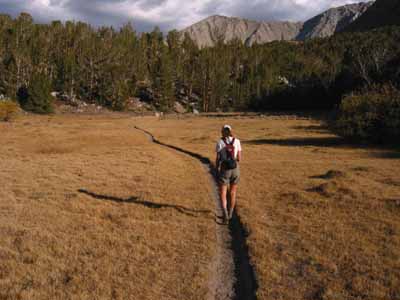 |
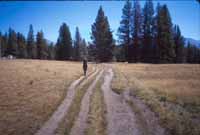 |
How do trails affect the surrounding habitat? The sectioning, or fragmentation, of meadow plant communities by trails is relatively apparent, but effects on fauna are more difficult to discern. Disturbance to vegetation may reduce habitat available for fauna to a greater extent than would be suggested by damage to plants, because even narrow gaps can greatly change the ratio of "edge" to "core" habitat in the surviving vegetation. We sampled meadow invertebrate fauna (e.g. insects and spiders) using transects that ran perpendicular to trails in order to assess functional fragmentation of the meadow assemblage. A secondary goal was to provide baseline data on this important terrestrial assemblage.
Five low elevation sites (Yosemite Valley) and five high elevation sites (Tuolumne Meadows) were sampled over a two-year period. Each site was sampled during both early (high soil moisture) and late (low moisture) season. At each site, a sample was taken in the trail, in meadow vegetation at the trail edge, and at 2, 5, and 10m distances from the trail. We developed a suction extraction technique for collecting surface-dwelling invertebrates: a Craftsman 320 gasoline vacuum modified with a mesh collecting chamber inserted in the two intake tube. Prior to vacuuming, a 0.5 m2 steel quadrat with a mesh covering was thrown onto a randomly-determined location along the transect and staked into place. The vacuum tube was then inserted through an elasticized hole in the mesh and worked through the vegetation to remove fauna.
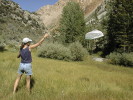 |
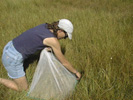 |
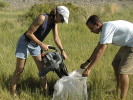 |
| Jutta
tosses the netted quadrat to quantitatively capture insects and other
invertebrates in a high alpine meadow. This method works really nicely
for enclosing a defined area without disturbing insects during approach.
The rebar-based quadrat is heavy enough to be easily thrown ten meters
and to sink deeply into vegetation. Quadrat tossing is destined to be
a new Olympic event. Lacey Greene photo. |
Staking
the trap at the corners prevents escape from under the edges. There is
an elasticized aperture in the top of the netting through which the suctioning
device is inserted. Lacey Greene photo. |
Jutta uses the vacuum to suction all the small animals from inside the trap (this research really sucks). Matt Goehring, WMRS intern, holds the netting away from the edges of the quadrat. The vacuum effectively sucks even surface-dwelling fauna from the meadow vegetation. We constructed a net that is inserted in the suction tube; after suctioning, the sample is emptied into a bag and sorted. We were surprised and pleased to find that animals are not damaged by this collecting technique. Lacey Greene photo. |
The meadow invertebrate assemblage proved to be remarkably diverse with relatively low dominance of any one form, even at the taxonomic level of order. Ants were the most abundant organisms (Hymenoptera; 24% of fauna), followed by Mites (Acari; 23% of fauna), beetles (Coleoptera; 11%), leafhoppers (Homoptera; 11%), flies (Diptera, 10%), and substantial numbers of spiders, bristletails, "true bugs", grasshoppers, caddisflies, moths, lacewings, and other insects. There were 178.4 arthropods/m2 in early season versus only 24.4/m2 in late season, and low elevation sites had 2.2 times the overall abundance of high elevation sites (139 versus 64 animals/m2).
Effects of trails extended further into the surrounding meadow habitat than would have been predicted on the basis of vegetation alone. Invertebrate assemblages in portions of meadows bordering trails had 24% of the abundance of "core" meadow areas across all species. Ants provide a good example of the extension of trail effects into intact meadow vegetation. There was an average of 1.6 ants per square meter in trails, and 5.0, 9.0, and 63.6 ants per square meter in vegetation next to trails, 2 meters from trails, and 5-10 meters from trails, respectively. Abundances on the trails were even lower than expected: there was a mean of only 10.2 invertebrates (of all types) per m2 of trail versus 157.5 animals/m2 of core meadow habitat.
So, why were there fewer animals near trails? It is likely that only a small amount of this pattern can be explained by direct mortality from trampling. Based on our previous work in other systems, there are probably several mechanisms at work. Likely culprits include: behavioral avoidance of edges in favor of homogenous "core" meadow, soil compaction and dewatering, thinning of vegetation, and use of the trail corridor by predators. Firmly establishing causation will require experimentation, and we would like to pursue this further.
Meadows harbor a diverse and sensitive assemblage of invertebrates that is not readily visible. Trails negatively influence higher trophic levels, including both primary (e.g., leafhoppers) and secondary (e.g., spiders) consumers. Invertebrates are affected over an area that is 20 times greater than that of the removed vegetation; footpaths should be planned with the understanding that ecological "footprints" of trails extend well beyond the confines of visible disturbance.
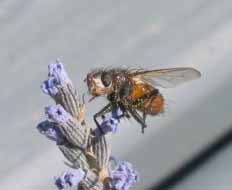 |
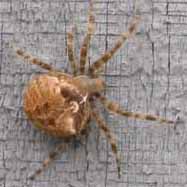 |
| That's
a fly, not a bee. Dipterans make up 99% of the fauna found in wet,
early season meadows, and you've no doubt been swarmed by them. But not
so fast — don't swat! Flies are important pollinators, like bees,
and are even more important in the detrital cycle. The entomologist Ross
Arnett points out that only bacteria and fungi exceed the role of Diptera
in breaking down dead plant and animal matter. Jeff Holmquist photo. |
Spiders
(Araneae) are more common in meadows than one would think — about
six per square meter. Don't hesitate to run barefoot through a backcountry
meadow though; almost all spiders are harmless. Jeff Holmquist photo. |
Further Reading:
Arnett, RH, Jr 2000 American insects: A handbook of the insects of America north of Mexico, 2nd ed. CRC Press, Boca Raton, FL. Excellent general taxonomic key.
Freedman, B 1995 Environmental ecology: The ecological effects of pollution, disturbance, and other stresses, 2nd ed. Academic Press, San Diego. The role of ecology in solving environmental problems.
Lubell, W, Lubell, C 1960 The tall grass zoo. Rand McNally, NY. A classic children's book likening arthropods in one's backyard to large mammals in a forest.
Strong, DR, Lawton,
JH, Southwood, R 1984 Insects on plants: Community patterns and mechanisms.
Harvard U Press, Cambridge, MA. Dated but very useful academic work on plant-animal
interactions.
This work was made possible by support from the Yosemite Fund.
Our Founder Questions? Go to About Our New Site |
Masthead
Photo from: |